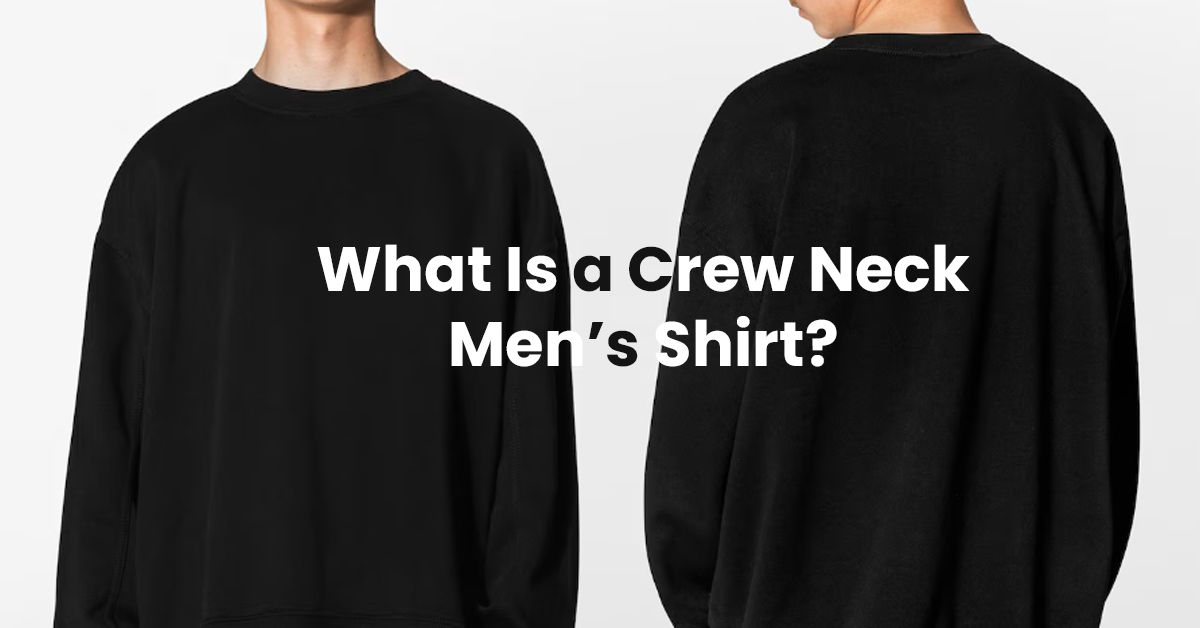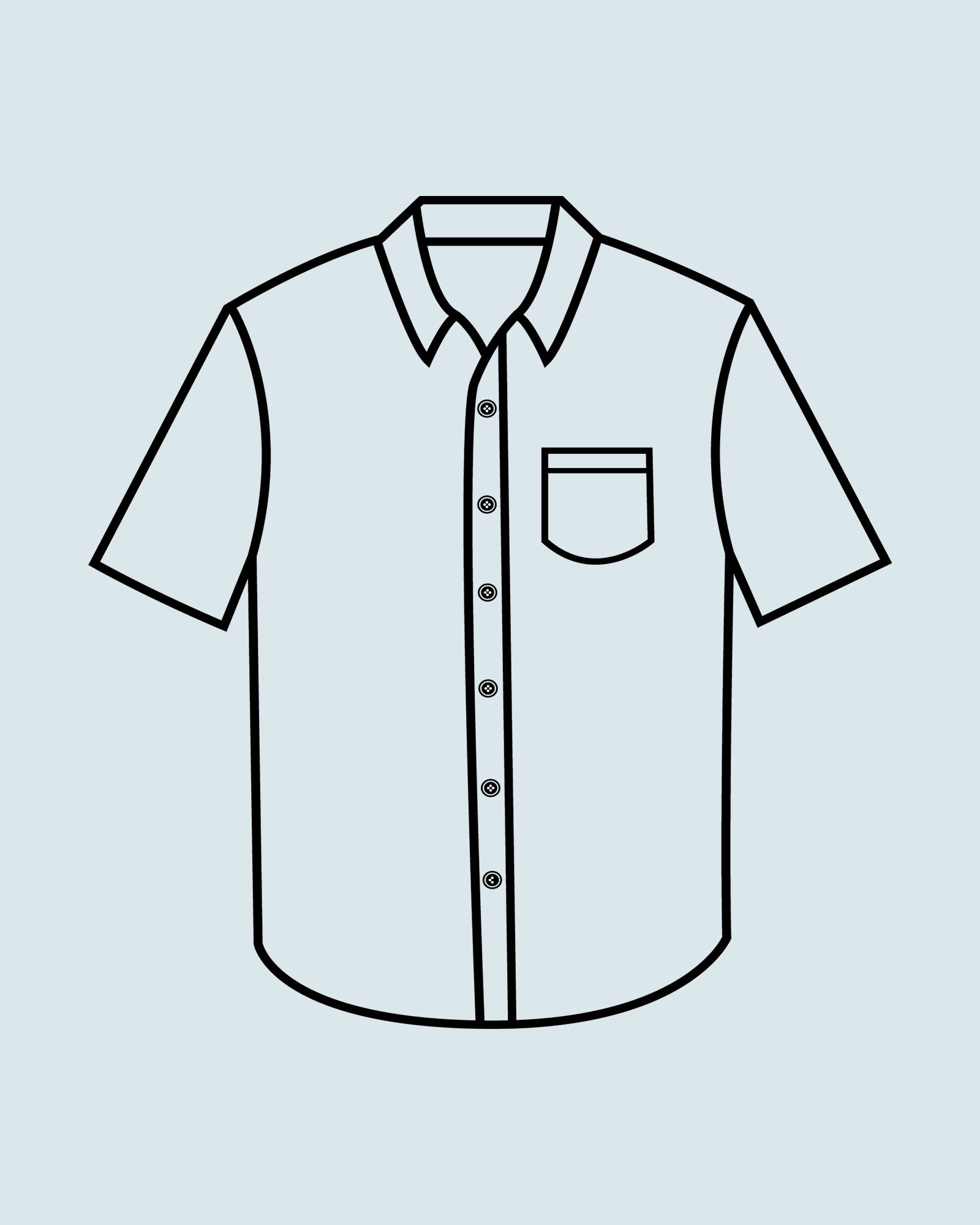A crew neck shirt is one of the most recognizable and versatile staples in men’s clothing. Defined by its round neckline and collarless design, this style of shirt has become a foundation piece in everything from streetwear and casualwear to gym gear and layering essentials. Whether you're wearing it under a blazer, pairing it with joggers, or using it as a standalone basic, the crew neck delivers a clean, timeless aesthetic that works for men of every age and body type.
What makes the crew neck especially valuable is its balance of comfort, simplicity, and structure. It flatters the shoulders, hugs the neckline without drooping, and allows for countless styling combinations. Over the decades, it has evolved from a military and athletic base layer into a fashion icon appearing in minimalist wardrobes, tech uniforms, and celebrity street style alike.
In this guide, we’ll break down everything you need to know about men’s crew neck shirts including how they’re designed, the difference between necklines, key fabrics to look for, their historical relevance, and how to style them for modern life. Whether you're buying your first or upgrading your collection, this is your complete reference for understanding the form and function of this menswear essential.
What Defines a Crew Neck Shirt?
A crew neck shirt is defined by its signature round neckline that sits close to the base of the neck, with no collar or buttons. The edge of the neckline is typically reinforced with a ribbed band, offering structure and stretch that helps the shirt hold its shape over time. This design makes the shirt feel snug around the neck, preventing it from sagging or stretching out especially when layered under jackets, hoodies, or sweaters.
What sets the crew neck apart from other necklines is its conservative, high-cut neckline, which offers a cleaner and more contained visual compared to styles like the V-neck (which dips into the chest) or the scoop neck (which has a deeper, curved cut). While V-necks are often chosen to elongate the neck or show off accessories, and scoop necks have a more relaxed, fashion-forward vibe, the crew neck maintains a classic and universally flattering profile. It also differs from mock necks, which feature a slight collar that stands up but doesn’t fold like a turtleneck.
Crew necks are most commonly found in t-shirts, sweatshirts, and base layers, but they're also used in elevated pieces like fine-knit sweaters and performance training tops. The design serves both function and form, it helps trap body heat in colder settings while offering a polished neckline that works well on its own or under layers. Because of its versatility and timeless appeal, the crew neck remains one of the most popular neckline styles in global menswear today.
A Brief History of the Crew Neck
The crew neck shirt traces its roots back to the early 20th century, where it was first introduced as an undergarment for U.S. Navy sailors. Designed to be worn beneath uniforms, the tight, round neckline helped prevent chest hair from showing and added an extra layer of warmth during strenuous work on ships. Its name "crew neck" is derived from its use by rowing and naval “crew” teams. Its functional, no-frills construction quickly made it a staple in athletic and military wardrobes.
From Utility to Everyday Essential
By the 1930s and ’40s, the crew neck transitioned from strictly functional use to a part of everyday American workwear. Factory workers and laborers embraced the style for its simplicity, comfort, and ease of movement. After WWII, returning servicemen continued wearing their basic tees including crew necks which helped them become normalized outside of the military.
Pop Culture & the Crew Neck Revolution
In the 1950s, the crew neck gained iconic status when it became associated with Hollywood rebels like James Dean and Marlon Brando. Wearing a plain white crew neck tee with jeans became a symbol of youthful defiance and masculine cool. Through the decades, musicians, athletes, and celebrities continued to adopt the crew neck as a blank canvas for personal style cementing it as a timeless essential.
The Modern Minimalist Uniform
Today, the crew neck remains a core piece in men’s fashion. It has evolved into everything from luxury basics and high-performance activewear to streetwear staples and office-casual layering pieces. Its clean neckline complements a range of body types, fits seamlessly into minimalist wardrobes, and aligns with today’s preference for versatile, seasonless essentials. Whether in cotton, technical fabric, or fine knit, the crew neck continues to represent simplicity done right.
Fit, Fabric & Function – What to Look for in a Quality Crew Neck Shirt
A great crew neck shirt isn’t just about looks, it’s about how it fits, feels, and performs throughout your day. From relaxed weekends to high-performance training, the perfect crew neck adapts to your lifestyle while offering a flattering silhouette and breathable comfort.
Slim vs. Classic Fit: Choosing for Your Body Type
Slim-fit crew necks are cut close to the body and typically taper at the waist. They’re ideal for athletic builds or men who want a more tailored, modern look. These shirts are great for layering or wearing on their own in smart-casual settings. On the other hand, classic-fit crew necks offer a bit more room in the chest, shoulders, and torso. They're better suited for daily wear, lounging, or when comfort is the priority. Classic fits also work well for broader or heavier builds without clinging to the body.
Best Fabrics for Everyday Comfort
When shopping for a quality crew neck, fabric matters just as much as fit. The gold standard is 100% combed cotton, which offers unmatched softness, breathability, and moisture absorption. For more durability and wrinkle resistance, cotton-poly blends are a practical choice they retain shape better and often dry faster. Performance materials, such as polyester or spandex-infused blends, are engineered for gym use, activewear, and hot weather they wick sweat, stretch with movement, and resist odor.
Each fabric serves a purpose. Choose cotton for a clean, everyday essential, blends for travel and work, and performance materials for athletic wear.
Function: Where and When to Wear It
Crew neck shirts are prized for their versatility. A slim, well-fitted cotton crew neck can be worn under a blazer for business casual days. A relaxed-fit crew neck in heavier fabric becomes a go-to for cool-weather layering. For workouts, a moisture-wicking performance tee keeps you cool and dry. And when it’s time to relax at home, there’s nothing better than a soft, oversized crew neck paired with joggers or shorts.
Whether you're building a capsule wardrobe or need something reliable for every day, the fit fabric–function combo defines the long-term value of a crew neck shirt.
Styling a Crew Neck Shirt – From Basics to Smart Casual
One of the biggest advantages of a crew neck shirt is its styling versatility, it adapts effortlessly to a range of aesthetics, from minimalist streetwear to elevated smart casual. If you choose the right fit, color, and fabric, a crew neck can be dressed up or down depending on the occasion and season.
Start with the core pairing options. A well-fitted crew neck t-shirt with jeans is a go-to for casual days—opt for a mid-weight cotton shirt in white, black, or heather gray for a timeless, clean look. For a more refined feel, pair your crew neck with chinos especially in earthy tones like olive, sand, or navy. This smart-casual combination is perfect for weekend outings, casual Fridays, or date nights. If comfort is the goal, joggers or tailored sweatpants offer a laid-back look when paired with an oversized or relaxed-fit crew neck.
Layering also plays a big role in styling. The snug neckline of a crew neck makes it an ideal base layer under flannel shirts, denim jackets, or blazers. For a streetwear-inspired look, throw a bomber or utility jacket over a neutral crew neck. For something more structured, a cotton crew neck in a solid color under a blazer strikes a balance between comfort and polish. Stick with monochrome tones or minimal branding to keep the outfit sharp.
When choosing colors, consider your skin tone and the rest of your wardrobe. Cool undertones (pink or bluish skin) tend to look best in navy, charcoal, and cool greys, while warm undertones (yellow or golden skin) pair better with olive, rust, cream, and tan. If your wardrobe leans neutral, adding a few accent crew necks in muted seasonal shades like forest green or burgundy can add dimension without clashing.
Crew Neck vs. V-Neck – Which One Should You Choose?
While both crew necks and V-necks are staples in men’s wardrobes, they serve very different aesthetic and functional purposes. Choosing the right one depends on your body type, styling preferences, and the overall vibe you want to project.
Visually, a crew neck offers a rounded, high neckline that creates a more balanced silhouette for those with longer necks, narrower shoulders, or a leaner frame. It frames the face in a way that feels classic and modest, making it suitable for layering or standalone use. Because of its symmetry and clean lines, it works well in structured outfits and under outerwear especially in smart-casual looks or professional layering.
The V-neck, on the other hand, features a downward-pointing cut that opens up the chest area. This elongates the neck and can visually slim down a rounder face or broader torso, making it ideal for men with larger builds or shorter necks. It’s also better for highlighting accessories like chains or pendants, and allows more breathability around the neckline making it a popular choice in warmer weather or under button-down shirts.
In terms of occasions, crew necks are more versatile and universally flattering they can transition from gym wear to casual or even smart casual events. V-necks, while slightly less formal, offer a relaxed vibe for summer, vacations, or nights out. Just avoid deep V-necks unless you're intentionally going for a fashion-forward or statement look.
Ultimately, neither neckline is “better” it comes down to how you plan to wear it, your facial and body structure, and your overall wardrobe style. Most men benefit from owning both types, with crew necks as their everyday go-to and V-necks as a seasonal or body-conscious alternative.
Caring for Crew Neck Shirts – Wash, Dry & Store Without Stretching
A well-made crew neck shirt can last years but only if it's cared for correctly. Improper washing and drying can cause collar curling, neckline warping, and premature fabric wear, especially in cotton or blended fabrics. The good news? With a few simple adjustments to your routine, you can preserve the structure and softness of your crew neck shirts for the long haul.
Start by washing crew necks inside out in cold or lukewarm water on a gentle cycle. This helps reduce surface abrasion on the fabric, maintains the integrity of the print (if any), and most importantly protects the collar seam from excessive friction. Avoid overloading the machine, as tightly packed cycles increase stretching and misshaping. For premium fabrics like Pima cotton or stretch blends, opt for a mild detergent with no harsh enzymes.
When drying, skip the high-heat tumble. Intense heat weakens the elastic around the neckline and causes shrinkage over time. Instead, either lay the shirt flat to dry or hang it on a padded hanger, ensuring the neckline is supported evenly. Never hang wet shirts by the collar alone this leads to sagging and deformed necklines.
To prevent the dreaded collar curl, avoid twisting or wringing the shirt, and skip ironing the neckline directly. If needed, use a low-steam setting and press with a protective cloth over the collar. Lastly, store crew necks folded neatly in a drawer or on wide, structured hangers to avoid shoulder bumps or neckline drag.
By following these simple care techniques, you’ll maintain both the fit and aesthetics of your favorite crew necks and get far more wear per dollar spent.
Conclusion: Why Every Man Needs a Reliable Crew Neck Shirt
The crew neck shirt isn’t just a style choice it’s a wardrobe cornerstone. Its clean neckline, effortless silhouette, and adaptability make it a daily essential that supports almost every outfit. Whether you're layering it under a jacket, pairing it with joggers for a casual day out, or using it as an elevated basic, the crew neck delivers a balanced mix of comfort, utility, and style.
What sets great crew necks apart isn’t just how they look, but how they fit your lifestyle from fabric durability and seasonal breathability to layering flexibility and color coordination. With a solid understanding of fit, fabric, and care, you're now equipped to choose crew necks that align with your taste and needs whether you’re shopping for performance wear, everyday casuals, or capsule wardrobe essentials.



